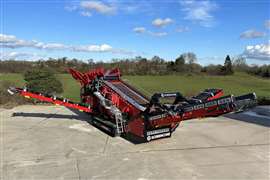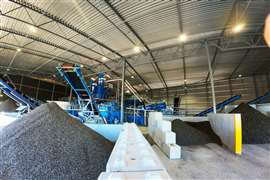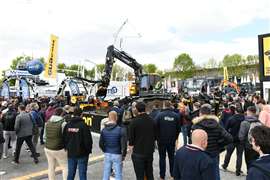Concrete ideas
07 January 2016

When the Schlossberg tunnel in Switzerland was rebuilt, the 50-year-old, worn out, concrete inner lining had to be demolished and replaced.
For the construction companies involved – Strabag and Granella – this was a genuine challenge. The tunnel is part of one of the city’s main routes and any disturbance, even on a weekend, can cause major traffic problems.
For this reason, the time allocated for the complete removal of the tunnel lining was extremely short. The work started at 5 pm on Friday and had to be completed by 5 am on the Monday. Careful planning and skilled execution were required.
The first step in the demolition process was to remove the roof section which released the stress in the concrete lining.
For this difficult task, which required a demolition method creating minimal vibration, two excavators fitted with ER 1500 size rotary drum cutters were used.
The drum cutters removed the concrete with great accuracy while meeting safety requirements. After removing the inner lining from the tunnel roof, the remainder was cut out and crushed. All excavator attachments were supplied by Gebrüder Egli.
Thanks to the equipment and the excavation method used, the Schlossberg tunnel was re-opened first thing Monday morning for traffic.
In neighbouring Austria, Tyrolit has introduced what it called the world’s first solution for easy, cost-effective dry drilling of reinforced concrete without using water.
The system consists of the DME19DP*** drill motor with soft impact function and the TGD dry drill bits that have been specially developed for dry drilling.
Selected partners have been benefitting from this system since the start of this year and now, following excellent test results and positive customer feedback, it is now available from Tyrolit distribution companies and partners worldwide.
“Our TGD dry drill bits have proven their worth in a variety of situations, including decommissioning nuclear power plants. We’re not at all surprised that our customers on smaller construction sites also achieved excellent results,” said product manager Sergiy Avramenko.
Diamond drilling
United Kingdom-based diamond drilling and controlled demolition firm D-Drill has successfully removed 40 tonnes of concrete from a shopping centre in Slough in the south of England – without disturbing shoppers, diners or nearby cinema goers.
Main contractor,RGB Group called in D-Drill to remove the 40 m (131 ft) long, 1.2m (3.9 ft) high and 325 mm (1.1 ft) thick concrete wall at a shopping centre in the town.
The wall had, unusually, been constructed in front of stock room windows so no natural light was available to the rooms which were 9 m (30 ft) above the ground floor.
D-Drill was tasked with removing the wall quietly and without disrupting the businesses beneath to allow the stock rooms to be converted into residential apartments.
John Barber, who runs the company’s Hampshire office, said: “Ideally, we would have carried out a series of diamond saw-cuts to work the wall into manageable sections and hoist away with a mobile crane.
“However, the amount of slurry that would have created would not have been conducive to allowing the businesses – such as shops and restaurants – to continue trading.
“Also, the sections would need to be removable by hand as no crane or hoisting facility could get into the location, particularly as the street had to remain live and open.”
John devised a method where D-Drill’s engineers would use a silent, non-percussive method of controlled demolition that would see a series of holes drilled strategically to then allow a hydraulic burster to break-up and reduce the wall to rubble.
It could then be removed systematically to prevent overloading the temporary scaffolding.
John added: “There was heavy steel reinforcement contained within the concrete so it was necessary to increase the amount of holes we drilled and we introduced a diamond saw-cut which helped to increase the efficiency of the hydraulic burster.
“The method proved to be extremely successful and a team of two was removing 2 to 3 m2 (21.5 to 32 ft2) of concrete in a shift.
Following the work the residential apartments have been completed and are now fully occupied, and RGB Group has selected D-Drill to work on five more major projects.
John said: “It’s a great testament to the team that we landed further work with RGB on the back of Slough. We devised a bespoke method and we are delighted that it proved so successful.”
Pump installation
In another project, this time in south Wales, engineers from D-Drill’s Bridgend office removed three large concrete plinths from the Nantgaredig Intake Works to allow for three new water pumps to be installed.
The firm used specialist 3D scanning equipment to scope out the job before removing the concrete. Special harness equipment had to worn during the scanning process due to the limited access.
D-Drill, working with main contractor IPP Contracting, Welsh Water and Celtic Process Control, then removed each of the 4.6 m (15 ft) x 2.2m (7 ft) x 500 mm (1.6 ft) plinths over the course of four days
Due to the size of the plinths and the tight working conditions, the plinths were cut into smaller 1.1 m (3.6 ft) x 400 mm (1.3 ft) x 430mm (1.4 ft) blocks to allow for the removal.
And, because of the ‘blue water’ environment, the firm had to take additional precautions against any contamination of the water or the surrounding machinery.
Having initially carried out the scanning of the plinths to find out where was best to cut the concrete, the team then used breakers and a three phase track saw to cut and remove the blocks.
Alan Burnell, of the Bridgend office, said: “The actual cutting of the concrete wasn’t particularly complicated, but the fact that we were working in a very confined area and also the fact that we had to be extremely careful with regards to contamination added to the complexity.
“We had everything scanned beforehand and that produced 3D images of exactly what was beneath the concrete so we knew what we were working with.
“We then devised the idea of cutting the plinths into blocks and worked solidly for four days in making the cuts and then removing the blocks accordingly.
“It wasn’t just D-Drill, there were several parties involved and we all worked very closely together to ensure that we got the job done to allow for the new pumps to be delivered and installed.
“The previous pumps had been there since the 1960s and so had the plinths so the new plinths needed to be created to meet the specification of the new pumps being installed.
“The project went extremely well from our point of view and it’s always great to see a complex plan formulated and then executed so well.”
This article is adapted from the November-December 2015 issue of Demolition & Recycling International. To see the full article with additional photos, or to register to receive regular issues of the magazine, please visit www.khl.com/subscriptions/dri
CONNECT WITH THE TEAM








